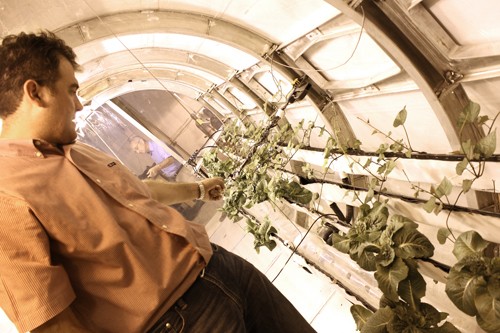Some miles off campus lays a part of the UA most people are unaware of. Passing through crops and horses, you stumble upon large boxes containing a lot of green. In this warehouse-style complex is an 18-foot-long white tube where lettuce and sweet potatoes are being grown with no soil or sunlight.
Someday, people may be doing just that on the moon and beyond, having fresh salads up in space. “”This is something to feed them (astronauts), keep them alive,”” said Gene Giacomelli co-principal investigator, professor and director of the Controlled Environment Agriculture Center. “”Ultimately, all of this will be applied to Earth, saving water, saving nutrients, producing good, quality food.””
Researchers are developing the ability to grow plants with electric power to provide light, water, nutrients and carbon dioxide in an artificial environment in parts of the world — or the universe — where soil or sunlight is unavailable or where weather conditions aren’t ideal.
“”If you can’t bring your oxygen, you bring plants in a growing system and allow this to be your life support. And it provides you with food, too,”” Giacomelli said.
Funded by the NASA Ralph Steckler Space Grant Colonization Research and Technology Opportunity, the study hopes to master the production of vegetables in these conditions, hydroponically — with nutrients being directed to the plants — so astronauts can get oxygen, water and food on space in a way that is close to self-sufficient. The study’s results so far state that an 18-foot-long tube can provide all the water, oxygen and half a person’s caloric needs per day.
The system, near East Roger Road and North Campbell Avenue, reuses all excess water and oxygen produced by the plants in a highly efficient way as not to waste any resources.
“”A group (on a spaceship) could live a long time (off this) because of the recycling nature of it,”” Giacomelli said.
In return, the research can apply its findings to grow better, more efficient crops on Earth using “”less energy, water and labor.”” Strawberries were once grown in the unit, and baby tomatoes will be grown next.
The project’s applications are one of the most exciting aspects of the project for Murat Kacira, co-principal investigator and associate professor at the CEAC. He takes care of the “”telepresence,”” a camera monitoring the system continually, as well as sensors measuring light levels, humidity and other factors that make the environment ideal for plant growth. Keeping space in mind, all data needs to be carefully monitored and recorded for NASA.
The team has three other researchers working on the project. Before receiving the grant, which they got with support from UA’s Lunar and Planetary Laboratory, the center already had a successful example of a similar experiment. For five years, crops have been grown without soil and sunlight at the Antarctica using a unit built at the UA. According to Giacomelli, the unit can feed up to 225 people.
“”Everybody gets a salad a day,”” Giacomelli said.
Brandon Jewell, a former UA plant sciences graduate student, closely monitors the plants.
“”It’s applicable to places where you can’t get to people really fast like in submarines, Antarctica, eventually the moon,”” Jewell said. “”Those places have machines and equipment to gather their water but it’ll only last for so long. (With plants) you can just plant more. It’s a two-for-one thing. They’ll clean the air or the water for the nutrients.””
In places where people are deprived from sunlight or isolated indoors such as in Antarctica or on a spaceship, the plants can also give them a “”psychological boost,”” Giacomelli notes.
Phil Sadler, president of Sadler Machine Co., built all the units in Tucson. Before the group received the NASA grant, most of the money to maintain the project came from Sadler and from Giacomelli’s university research account. The project is expected to end in two weeks. The team hopes to deliver its results to NASA. In January, if the results are as expected, the group could receive a larger grant to expand and intensify studies of the system.
As for their earthly advantages, Giacomelli recognizes greenhouses are still an expensive endeavor for most people. But he also notes that per acre a year, one greenhouse can produce 10 times what regular growing methods can because of its high efficiency.
This, however, doesn’t mean the end of agriculture in the field, he says. Rice, wheat, cereal crops “”still, for the most part, need to be grown on fields.””
“”We need (it) … or else we’d all starve,”” Giacomelli said.
The grand scheme, he envisions, is for the system to feed “”people in places where maybe they never had fresh vegetables, or very often; in the deserts of the world, in the Middle East.””









